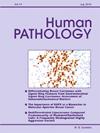Histologic alterations are common in Monogenic Disease patients with ‘healthy’ endoscopy: Results from a GIPAD-GIPPI multicenter study
IF 2.7
2区 医学
Q2 PATHOLOGY
引用次数: 0
Abstract
Objective
Very early-onset inflammatory bowel disease (VEO-IBD) is a clinical umbrella term referring to IBD-like symptoms arising in children before 6 years of age, encompassing ‘pure’ IBD (Crohn's Colitis/Ulcerative Colitis)/non IBD colitis, and monogenic diseases (MDs), the latter often related to primary immunodeficiency disorders. A multidisciplinary approach is imperative for correct therapeutic management, as endoscopy and histology are not always completely informative. In this setting, the study aims to describe the extent/features of histologic lesions in both endoscopically damaged mucosa and otherwise endoscopically healthy (normal/near normal) mucosa.
Methods
Endoscopic data were retrospectively recorded, and histologic slides were collegially re-evaluated in a 93 VEO-IBD multicenter cohort, 76 (76/93 - 81,7 %) of which with complete endoscopic/histologic data.
Results
At endoscopy, lesions were reported by the clinician in 66/76 (86,8 %) cases. When endoscopic lesions were reported, histologic damage was also seen. Interestingly, histologic mucosal damage was also documented in 43,3 % (13/30) of cases with endoscopically healthy/nearly healthy mucosa. This misalignment between endoscopy and pathology was seen in about a third of (29,1 % - 7/24) ‘true’ IBD and all MDs (100 % - 6/6) (p = 0.0029).
Conclusion
In VEO-IBD, histologic lesions can be present in endoscopically ‘healthy’ intestinal mucosa. This finding is more frequent in MDs, suggesting the need to accurately sample all the mucosal tract in VEO-IBD patients, even when no endoscopic lesions are seen at endoscopy.

组织学改变在“健康”内窥镜检查的单基因疾病患者中很常见:来自GIPAD-GIPPI多中心研究的结果
非常早发性炎症性肠病(VEO-IBD)是一个临床总称,指6岁以下儿童出现的IBD样症状,包括“纯”IBD(克罗恩结肠炎/溃疡性结肠炎)/非IBD结肠炎和单基因疾病(MDs),后者通常与原发性免疫缺陷疾病有关。多学科的方法是必要的正确的治疗管理,因为内镜和组织学并不总是完全信息。在这种情况下,本研究旨在描述内镜下受损粘膜和内镜下健康(正常/接近正常)粘膜的组织学病变的范围/特征。方法回顾性记录内镜资料,并对93例VEO-IBD多中心队列的组织学切片进行重新评估,其中76例(76/93 - 81.7%)具有完整的内镜/组织学资料。结果66/76例(86.8%)患者经内镜检查发现病变。当内窥镜病变报告,组织学损害也可见。有趣的是,在43.3%(13/30)的内镜下粘膜健康/接近健康的病例中也记录了组织学上的粘膜损伤。在三分之一(29.1% - 7/24)的“真”IBD和所有MDs(100% - 6/6)中,内窥镜检查和病理检查之间存在这种不一致(p = 0.0029)。结论在VEO-IBD中,内镜下“健康”的肠黏膜可出现组织学病变。这一发现在MDs中更为常见,提示即使在内镜下未发现内镜病变,也需要准确地对VEO-IBD患者的所有粘膜道进行采样。
本文章由计算机程序翻译,如有差异,请以英文原文为准。
求助全文
约1分钟内获得全文
求助全文
来源期刊

Human pathology
医学-病理学
CiteScore
5.30
自引率
6.10%
发文量
206
审稿时长
21 days
期刊介绍:
Human Pathology is designed to bring information of clinicopathologic significance to human disease to the laboratory and clinical physician. It presents information drawn from morphologic and clinical laboratory studies with direct relevance to the understanding of human diseases. Papers published concern morphologic and clinicopathologic observations, reviews of diseases, analyses of problems in pathology, significant collections of case material and advances in concepts or techniques of value in the analysis and diagnosis of disease. Theoretical and experimental pathology and molecular biology pertinent to human disease are included. This critical journal is well illustrated with exceptional reproductions of photomicrographs and microscopic anatomy.
 求助内容:
求助内容: 应助结果提醒方式:
应助结果提醒方式:


